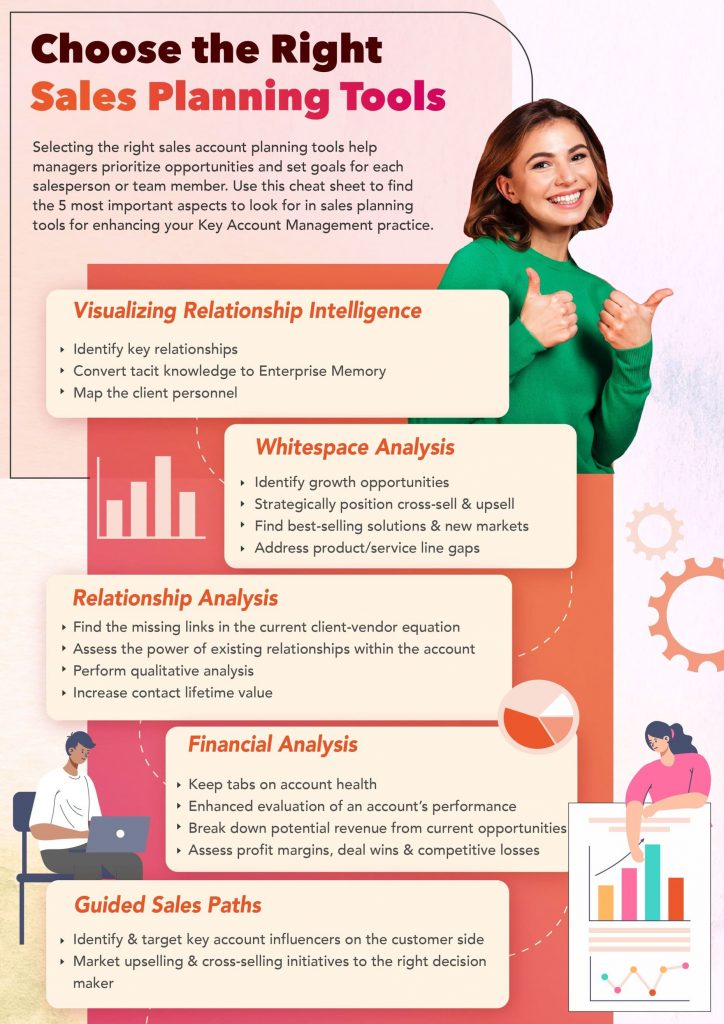The quest for the right solution is never-ending in B2B spheres, as organizational needs constantly change and evolve. Large organizations rely on technology to streamline their processes and improve their efficiency – and are constantly looking for tools that can help them in this regard. With digital key account management tools, sales teams can offer numerous advantages over traditional methods, including increased security, convenience, and visibility. Buyer behavior has drastically changed over the last couple of years, and a significant portion of post-pandemic interactions are expected to remain virtual. This shift in behavior has brought key account management to the forefront of many organizations’ strategies, prompting CSOs and CROs to rethink their approach to managing accounts. With key account management evolving and becoming more complex, organizations are turning to AI as a key differentiator and enabler.
Meeting buyer needs with digital account management solutions
Buyers have significantly changed their behaviors, and more personas are coming into the digital key account management sphere. It’s becoming critical for organizations to leverage technology to enable their employees to develop better connections with buyers. However, adding additional steps or work for the sales team can create friction and become a significant hurdle for organizations to leverage technology better. To create a frictionless and seamless process, organizations must evaluate the additional work that gets added on to the sales team when they are selling. This approach is not just about technology; it’s about how technology and processes can work together to create a better experience for everyone involved. Large clients are looking for solutions that can help them drive optimize processes, streamline growth and reduce costs. However, the decision-making process can be complex, involving multiple stakeholders, technical buyers, and influencers. As a result, companies need to have an effective key account management tool that can help them navigate this complex landscape and identify the key decision-makers within an organization.

Check out more on the DemandFarm account planning masterclass on ‘Making Account Plans Actionable, Measurable and Sustainable’ here.
Managing key accounts digitally is important for companies, as conversations have largely moved online – rendering the traditional methods powerless. Having tools to visualize the customer’s organizational structure, understand the influences among stakeholders, and identify key decision-makers provides much needed context for sales teams. With this context, key decision makers can use relationship maps to target the right decision makers.
- Start small and take a hypothesis-driven approach
Every company is different, and there is no one-size-fits-all approach to implementing and managing the relationship. The best way to manage is to test at a small scale and expand organically through the learnings. Develop a hypothesis for how the objectives can be accomplished and allow teams to test them out. By collecting data to measure success, teams can adjust course where needed. Iteratively testing and learning leads to an approach that works for the organization and can be scaled organically in the sales team.
- Find champions
Champions are the people in the organization who spearhead change and advocate for digitalization of key account management. They empower others to share the vision and help teams focus on the goal.
- Focus on competitive advantages
Finding ways to extend competitive advantages can involve white space mapping, identifying new opportunities with existing clients, or finding new clients for existing solutions. Having a unique digital relationship strategy gives a surgical and intentional approach for how sales teams identify key areas of communication. To build trust and relationships, sales teams can play on their strengths and highlight related features prominently to meet stakeholder needs.
One of the most important factors when selecting a digital key account management tool is its ability to integrate with the company’s existing solution set – so that teams don’t feel like they are using a third-party product. If the tool is easy to learn and operate, minimal training is required for employees to understand its functionalities. When implemented effectively, a digital key account management tool can transform the way companies manage their large clients. It can help sales teams to better understand their customers’ organizational structure and the key decision-makers involved in the purchasing process. This understanding can lead to more effective sales strategies and ultimately, increased revenue. Companies that work with large clients need to invest in digital key account management tools to effectively manage their relationships. By leveraging these tools, companies can gain a deeper understanding of their customers’ needs, and develop more effective sales strategies that drive growth and reduce costs.
The need for digital tools to manage customer relationships
Organizations have completely overhauled their strategies over the last two years, especially when it comes to customer relationship management. Small and medium sized businesses that rely heavily on personal interactions with clients now use a digital-first approach to Key Account Management. To remain relevant with customers, solution providers have to create and implement a digital account and relationship strategy that could help them retain or even grow their key relationships in this new remote world. There are a few factors that sales teams have to consider:
- Aiming for a data-driven approach to relationship strategy and management. As consultants, the sales team helps clients define business problems, collect data, and use that data to inform decisions that produce positive outcomes for their organization. However, by turning that lens internally, organizations can come up with a suitable approach to manage opportunities, and improve their outcomes through managing accounts and relationships.
- Managing culture and people changes is important while shifting to a new approach. It requires proactive and sustained communication across a variety of stakeholder groups to influence broad behavior change across the company. To make it stick, sales teams should align incentives and the way they measure things to reflect the business outcomes they really care about as a business.
- Enabling teams with the right tools powers them to punch well above their weight. Even with the best approach and a workforce ready for change, lack of infrastructure and relevant tools to do the work can cause frustration, inconsistencies, and operational hurdles. Supporting the change requires investments in infrastructure that can uplift sales teams, by making their jobs easier while removing some of the roadblocks and overheads.

To succeed in this shift, organizations must adopt a data-driven approach, align incentives to reflect business outcomes, and invest in the necessary infrastructure and tooling to support their workforce. By doing so, they can retain and even grow their key relationships in a remote world. Smart sales organizations respond by rolling out digital tools for their smaller accounts first to identify any weak points in strategies and processes, and supplementing them with sufficient interactions from key accounts managers. Learnings on these are then transferred to key accounts. With tools that put focus on buyer needs – with features like alerting reps when a key customer avails assistance using self-serve tools. Sales teams can create a bridge linking their digital platform and specialized help team with key customers, where they can get accurate information on the effectiveness whenever needed.
7 Benefits of shifting to Digital Key Account Management
In today’s business environment, customer centricity is a critical aspect of successful sales and marketing strategies. Organizations need to understand their customers deeply and develop personalized solutions to cater to their needs. Key account management (Key Account Management) is a popular approach that focuses on building long-term relationships with a select group of high-value customers. However, traditional Key Account Management practices can be time-consuming, inefficient, and may not provide real-time insights into customer needs. The good news is that advances in artificial intelligence (AI) and digital technologies have made it possible to transform Key Account Management practices and deliver more significant benefits to organizations. In this article, we will explore the advantages of moving to AI-enabled key account management and provide some guidance for organizations looking to make this shift.
1. Improved Customer Understanding and Personalization
AI-enabled Key Account Management can provide a deeper understanding of customers by leveraging data analytics, machine learning, and natural language processing techniques. By analyzing customer data such as purchase history, behavior, and preferences, AI algorithms can identify patterns and insights that can help organizations deliver personalized solutions to their customers. AI can also help automate routine tasks such as data entry, reporting, and lead prioritization, enabling sales reps to focus on building relationships with customers.
2. Enhanced Sales Collaboration and Cross-Selling Opportunities
AI-enabled Key Account Management can also enable sales teams to collaborate more effectively by providing real-time insights into customer needs and preferences. By leveraging AI-powered tools such as chatbots, sales reps can communicate more efficiently with customers, identify pain points, and offer relevant solutions. AI can also help sales reps identify cross-selling opportunities by analyzing customer data and identifying patterns across different accounts.
3. Increased Efficiency and Productivity
AI-enabled Key Account Management can help organizations streamline their sales processes and increase efficiency. By automating routine tasks and providing real-time insights into customer needs, AI can help sales reps prioritize their time and focus on high-value accounts. AI can also help sales teams monitor and track their performance by providing real-time dashboards and analytics.
4. Improved Security
One of the primary benefits of digital key account management is improved security. Digital key account management tools use encryption and other security measures to protect data from unauthorized access. This helps ensure that only authorized personnel have access to sensitive areas or information, minimizing the risk of security breaches.
5. Increased Convenience
Digital key management tools with AI-enabled features, however, allow for remote access control, enabling authorized personnel to access information from anywhere with an internet connection. This can be particularly useful for businesses with multiple locations or remote workers.
6. Improved Visibility
Digital key account management tools also provide improved visibility into key usage. Digital key management tools, on the other hand, allow for real-time tracking and reporting, making it easy to monitor key accounts and identify any potential issues. This can help businesses stay on top of their key account management processes.
7. Better Collaboration
Digital key account management tools can also improve collaboration between different teams and departments. By providing a shared platform for key account management, all stakeholders can have access to the same information and work together more effectively. This can be particularly useful for businesses with complex organizational structures or multiple teams working on the same project.
Bottom line!
Digital Key Account Management offers numerous benefits over traditional key account management methods, including increased security, convenience, visibility, and collaboration. By adopting digital key account management tools, businesses can streamline their key management processes, improve their security, and work more effectively across teams and departments. As technology continues to evolve, it is likely that digital key account management will become even more prevalent, making it an essential tool for businesses of all sizes. Organizations looking to make the shift to digital Key Account Management should develop a clear process for implementing best practices, so that all stakeholders are aligned with the approach. By involving sales team members in the Key Account Management process from the beginning, leaders can indirectly encourage them to live and breathe the customer experience.
Not only do sales reps develop a deeper understanding of customer needs, but also focus on developing personalized solutions for their key accounts. If the task of switching to a key account management platform seems daunting, then sales teams can start with a pilot project, select a small group of accounts, and evaluate the effectiveness of the Key Account Management process before scaling it up. Digital key account management can provide significant benefits to organizations, including improved customer understanding and personalization, enhanced sales collaboration and cross-selling opportunities, and increased efficiency and productivity.

